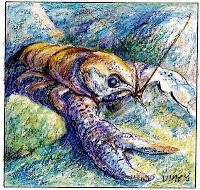
On the Marmorkrebs home page, I added the following text in bold a couple of months ago:
Marmorkrebs should not be kept in outdoor tanks or ponds, used for bait, or used in any other situation where they could be released into natural ecosystems.
I was pleased to see that this piece of advice was cited in
this thread on a fishing forum when someone asked if there were laws concerning the use of Marmorkrebs as bait. But it occurred to me that I should provide more information in support of the statement.

The sale of crayfish is a completely grey market, as I found trying to track down
pet ownership of Marmorkrebs. Trying to gather good information about the sale of crayfish for bait is hard, and as far as I can find, Bob DiStefano and colleagues have done probably one of the only systematic studies to examine this.
DiStefano and colleagues surveyed all the American state and Canadian provincial agencies in more detail than on my page. They found that about
half of the jurisdictions responding reported problems caused by crayfish used as bait. Yet of those, only a few had banned the use of crayfish as bait outright. The other states and provinces had some other legislation intended to prevent the introduction of exotic crayfish, such as limiting how far they could be transported. This tremendous hodgepodge of
rules and regulations doesn’t lend itself to easy enforcement.

The team also did extensive surveys of bait shops in Missouri. Missouri is one of the jurisdictions that has a series of regulations designed to prevent the spread of crayfish across watersheds rather than an outright ban. The state is
trying to do the right thing. But not surprisingly, the authors turned up a lot of illegal crayfish; in their brief surveys, 27% of the bait shops had illegal crayfish.
Some shops had legal crayfish species that were gotten by an illegal means (e.g., from out of state).
Almost
none of the shop owners had a clue about what species of crayfish they had.
Even if the bait shops were following all the laws (which were few and far between), there’s no way of knowing what the fishermen they sold the bait to did.
It’s difficult to know how many introductions have been caused by a combination of careless bait shop owners and fishermen, but this paper provides some hints of past introductions that could have been cause by crayfish being released as bait.
Procambarus acutus is mainly distributed in the south-eastern corner of the state, but there are pockets further north that are probably the result of bait sales.
Missouri is the only state or province so far to prohibit Marmorkrebs specifically, the chances are good that if you’re using Marmorkrebs as bait in many jurisdictions, you could easily be running afoul of some other law.
In short, using Marmorkrebs as live bait isn’t the problem; using
any crayfish as live bait is a problem! About the only exception would be a crayfish you catch at the bank of the river or lake you intend to fish in.
Reference
DiStefano RJ, Litvan ME, Horner PT. 2009. The bait industry as a potential vector for alien crayfish introductions: problem recognition by fisheries agencies and a Missouri evaluation. Fisheries 34(12): 567-597. DOI: 10.1577/1548-8446-34.12.586
 A new paper reviews the human uses of crayfish, and crayfish in human culture. It contains a single long paragraph about Marmorkrebs. Most of it will be familiar to readers of this blog, but I was intrigued by this section.
A new paper reviews the human uses of crayfish, and crayfish in human culture. It contains a single long paragraph about Marmorkrebs. Most of it will be familiar to readers of this blog, but I was intrigued by this section.




